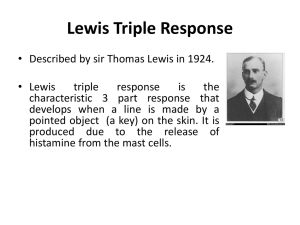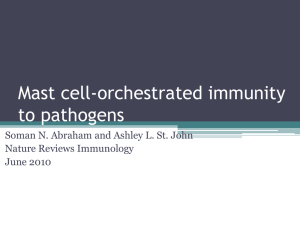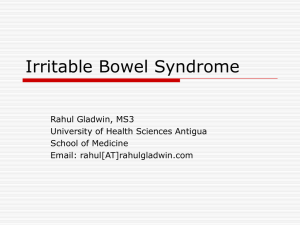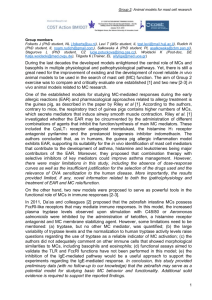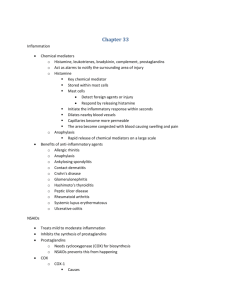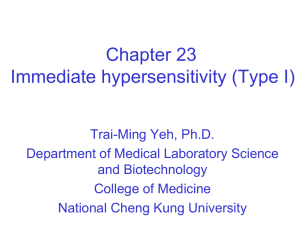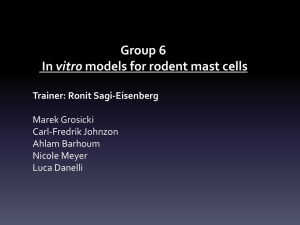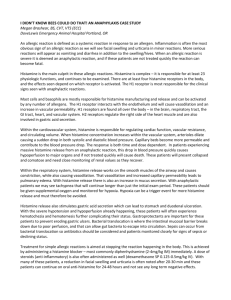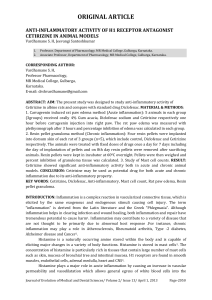View/Open - Lirias
advertisement
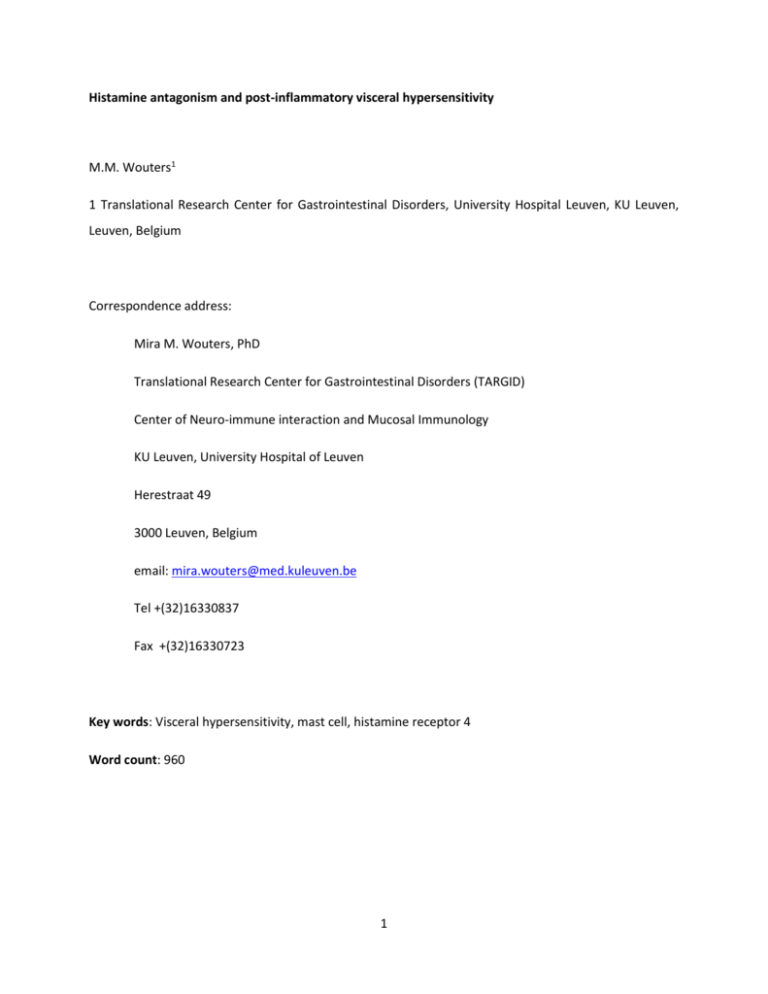
Histamine antagonism and post-inflammatory visceral hypersensitivity M.M. Wouters1 1 Translational Research Center for Gastrointestinal Disorders, University Hospital Leuven, KU Leuven, Leuven, Belgium Correspondence address: Mira M. Wouters, PhD Translational Research Center for Gastrointestinal Disorders (TARGID) Center of Neuro-immune interaction and Mucosal Immunology KU Leuven, University Hospital of Leuven Herestraat 49 3000 Leuven, Belgium email: mira.wouters@med.kuleuven.be Tel +(32)16330837 Fax +(32)16330723 Key words: Visceral hypersensitivity, mast cell, histamine receptor 4 Word count: 960 1 Abdominal pain is one of the most difficult to treat symptoms in patients suffering from irritable bowel syndrome (IBS). Recent evidence shows that abnormal perception of visceral stimuli, or visceral hypersensitivity, represents an important underlying mechanism. Of interest, similar mechanisms may be involved in abdominal pain reported by ulcerative colitis (UC) and Crohn’s disease patients in remission. Although the underlying mechanisms are not fully understood, it becomes increasingly clear that intestinal inflammation may provide an initial stimulus for a persistent state of visceral hypersensitivity. Most insight in the role of inflammation in chronic abdominal pain comes from studies evaluating patients with post-infectious (PI-)IBS. Colonic biopsies of PI-IBS patients reveal no signs of overt inflammation but show persistent minor increases in epithelial T lymphocytes and mast cells (1), suggesting that long-term inflammatory changes may be responsible for colonic hypersensitivity. To date, mast cells are considered to play a key role in this process. Supernatant of mucosal biopsies of visceral hypersensitive IBS patients indeed contains more mast cell mediators such as serotonin, histamine, and proteases, that are able to activate visceral afferent nerve fibres (2). Moreover, abdominal pain in IBS patients was reported to be correlated with the number of activated mast cells in proximity of colonic nerves, further suggesting that mediators released by mast cells may play an important role in abdominal pain (3). One of the potential candidate mast cell mediators involved is histamine. Histamine is synthesized in all human tissues, but is particularly abundant in skin, lung and gastrointestinal tract. Mast cells are a prominent source of histamine, although histamine is to a lesser extent also secreted by basophils, histaminergic neurons and microbiota. Four histamine receptors have been identified, all of which are G protein-coupled receptors, that are designated H1 through H4. In the skin, histamine is mainly released from mast cells in response to crosslinking of IgE molecules expressed on the cell membrane by allergens. Once released, it induces itch by excitation of a subset of afferent, histamine-sensitive unmyelinated C-fibers, although recent studies demonstrate that histamine can also trigger neurogenic inflammation (4) and pain. At least in the skin, multiple HRs seem to be involved in these processes. Blockade of H1R and H2R by pyrilamine and ranitidine respectively reduces pain induced by subcutaneous injection of formaline in the paw (5) and inhibits both thermal and mechanical hyperalgesia following nerve injury (6). Moreover, recent data support a role for H4Rs in inflammationinduced hyperalgesia: the selective H4R antagonist JNJ7777120 potently reversed both acute and chronic inflammatory pain following intraplantar carrageenan and complete Freund's adjuvant injection (7) and in carrageen induced pleurisy (8). In addition, JNJ7777120 significantly reduced hyperalgesia in neuropathic pain models of spinal and sciatic nerve ligation(7;9). In this issue of Gut, Deiteren et al. elegantly demonstrate that also in the intestine, H1R and H4R play a key role in aberrant pain perception following intestinal inflammation (10). The authors induced distal colitis in rats by intrarectal instillation of 2,4,6-trinitrobenzenesulfonic acid (TNBS). After resolution of colitis, confirmed by endoscopic healing and regression of the inflammatory infiltrate (T cells and MPO activity), the animals showed increased pain responses, assessed by the visceromotor response, to colorectal distention, indicating the presence of postinflammatory visceral hypersensitivity. Intriguingly, mast cell numbers were significantly increased in the colon of post-colitis rats compared to control rats. In addition, the spontaneous histamine release was threefold increased in specimens obtained from 2 post-colitis rats, indicating that mast cells and in particular histamine may play a key role in postinflammatory visceral hypersensitivity. This was further underscored by a dose-dependent reduction of pain responses evoked by colonic distention after treatment with the H1R antagonist levocetirizine. These findings are in line with previous studies supporting a role of H1R in visceral hypersensitivity in IBS patients and an animal model of IBS (11;12). Two recent proof-of-principle clinical trials confirmed the clinical relevance of these findings showing improvement of abdominal pain and global relief by the H1R antagonists ketotifen (12) and ebastin (13) in IBS patients. Most interestingly, Deiteren et al. present evidence that H4R may also be involved in visceral hypersensitivity. The selective H4R antagonist JNJ7777120 dose-dependently normalized the visceromotor response to colorectal distension, an effect that was potentiated when combined with a H1R antagonist. The results reported by Deiteren et al. are of extreme interest because they indicate an unexpected role for H4R antagonism in aberrant post-inflammatory pain perception. The role of H4Rs in visceral nociception may bear great potential for the treatment of post-inflammatory hypersensitivity although the underlying mechanism needs further study. In the colon, H4Rs are expressed on mast cells and immune cells (T cells and dendritic cells) but not on sensory neurons indicating an indirect effect of H4R antagonism on neuronal sensitivity. Even at the highest dose used by the authors, JNJ7777120 did not act as a mast cell stabilizer indicating that H4Rs probably do not play a role in mast cell degranulation (14). More studies are required to evaluate to what extent pro-inflammatory cytokines and mast cell mediators such as histamine contribute to inflammation and subsequent neuronal sensitivity in models of post-inflammatory hypersensitivity and if these immune parameters are modulated by H4R and H1R. One point of concern may perhaps be the high doses of JNJ7777120 used implying that interaction with other receptors, including H1R may have to be considered. Nevertheless, H4R has become a promising target for immuno-inflammatory diseases, such as allergic rhinitis, asthma or dermal allergies. Several proof of concept clinical trials are completed with H4R antagonists in asthma, allergic rhinitis and itch (15). As these agents are already available for human use, the data presented by Deiteren et al. beg for further studies evaluating the role of H4R in abdominal pain in IBS and IBD in remission, including clinical studies investigating the effect of H4R antagonists. Reference List (1) Ohman L, Simren M. Pathogenesis of IBS: role of inflammation, immunity and neuroimmune interactions. Nat Rev Gastroenterol Hepatol 2010;7(3):163-73. 3 (2) Buhner S, Li Q, Berger T et al. Submucous rather than myenteric neurons are activated by mucosal biopsy supernatants from irritable bowel syndrome patients. Neurogastroenterol Motil 2012;24(12):1134-e572. (3) Barbara G, Stanghellini V, De GR et al. Activated mast cells in proximity to colonic nerves correlate with abdominal pain in irritable bowel syndrome. Gastroenterology 2004;126(3):693702. (4) Rosa AC, Fantozzi R. The role of histamine in neurogenic inflammation. Br J Pharmacol 2013;170(1):38-45. (5) Mobarakeh JI, Torkaman-Boutorabi A, Rahimi AA et al. Interaction of histamine and calcitonin gene-related peptide in the formalin induced pain perception in rats. Biomed Res 2011;32(3):195-201. (6) Zuo Y, Perkins NM, Tracey DJ et al. Inflammation and hyperalgesia induced by nerve injury in the rat: a key role of mast cells. Pain 2003;105(3):467-79. (7) Hsieh GC, Chandran P, Salyers AK et al. H4 receptor antagonism exhibits anti-nociceptive effects in inflammatory and neuropathic pain models in rats. Pharmacol Biochem Behav 2010;95(1):4150. (8) Pini A, Somma T, Formicola G et al. Effects Of A Selective Histamine H4r Antagonist On Inflammation In A Model Of Carrageenan-Induced Pleurisy In The Rat. Curr Pharm Des 2013. (9) Smith FM, Haskelberg H, Tracey DJ et al. Role of histamine H3 and H4 receptors in mechanical hyperalgesia following peripheral nerve injury. Neuroimmunomodulation 2007;14(6):317-25. (10) Deiteren A, De Man JG, Ruyssers NE et al. Histamine H4 and H1 receptors contribute to postinflammatory visceral hypersensitivity. Gut 2014. (11) Stanisor OI, van Diest SA, Yu Z et al. Stress-induced visceral hypersensitivity in maternally separated rats can be reversed by peripherally restricted histamine-1-receptor antagonists. PLoS ONE 2013;8(6):e66884. (12) Klooker TK, Braak B, Koopman KE et al. The mast cell stabiliser ketotifen decreases visceral hypersensitivity and improves intestinal symptoms in patients with irritable bowel syndrome. Gut 2010;59(9):1213-21. (13) van Wanrooij, S. J., Wouters, M. M., van Oudenhove L., Vermeire, S., Rutgeerts, P., and Boeckxstaens, G. E. Effect of the H1-receptor antagonist ebastin on visceral perception and clinical symptoms in IBS. Gastroenterology 144, S-160. 2013. Ref Type: Abstract (14) Hofstra CL, Desai PJ, Thurmond RL et al. Histamine H4 receptor mediates chemotaxis and calcium mobilization of mast cells. J Pharmacol Exp Ther 2003;305(3):1212-21. 4 (15) Salcedo C, Pontes C, Merlos M. Is the H4 receptor a new drug target for allergies and asthma? Front Biosci (Elite Ed) 2013;5:178-87. 5
